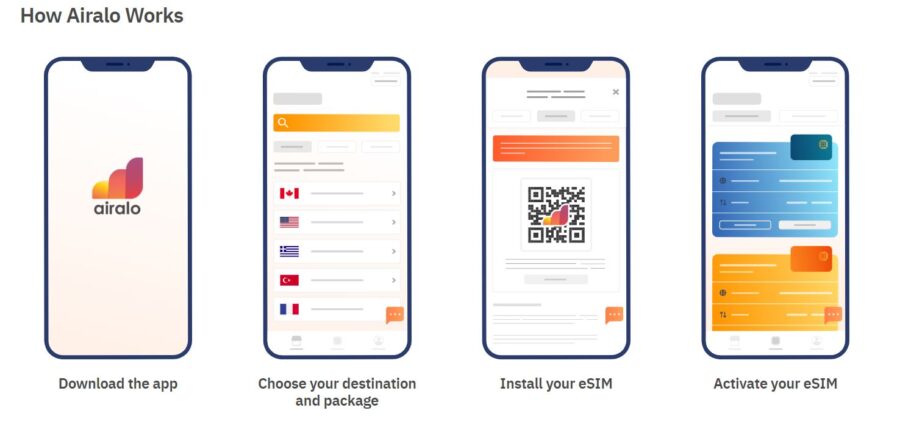travel, Travel Guides, Travel Tips
Travel Like a Pro with eSIM: Say Goodbye to Roaming Fees!
Have you heard of an eSIM before? Well, I didn’t until recently. We had some drinks when friends of mine brought the eSIM into a conversation about their trip to South East Asia. As it usually goes with travel-related topics, I needed to know more. After doing some external research, I am happy to share why these eSIMs are incredibly convenient for travellers—making it an essential subject on my website!
In short, an eSIM allows you to switch providers without making physical changes to your device. Although, there is more to the subject than that, so let me tell you more:

This post contains affiliate links. If you use these links to buy something we may earn a commission at no additional cost for you. Thanks.
What is a SIM, and what is an eSIM?
SIM, short for Subscriber Identity Module, is the little card inserted into a mobile device, allowing you to connect to a specific mobile network. Invented in 1991, these SIMs are essential to identify the subscriber to the network and permit them to call, text or connect to the network’s internet. Over time these little cards have evolved from the MiniSIM to the MicroSIM, the NanoSIM and now the eSIM.
The term eSIM is short for an embedded sim card. Instead of removing or replacing a SIM card, this one integrates into a device. It’s simply a tiny chip that can store all the information traditional SIM card store. Or in other words, all the information required to connect to a mobile network.
Why do we need a SIM or an eSIM while travelling?
As with many things, we don’t need an eSIM or a SIM card to travel, especially short-term travel. It doesn’t hurt to be unable to connect to the local internet for a while. However, buying a local SIM card or eSIM is essential if you travel long-term or switch countries regularly.
When a mobile device gets used outside of its home network, it needs to connect to international networks to call, text or access the internet. The customer pays the cost of using these networks under Roaming Fees, which are significantly higher than the cost of normal mobile usage. If you don’t buy a local SIM card outside your home country, you’ll pay Roaming Fees every time you access your mobile network.

What are the Benefits of an eSIM for travellers?
We don’t have the patience to wait for the internet in our accommodation, and honestly, we also don’t have to wait. Booking, transport, and flight apps require the internet to work correctly. Besides, who doesn’t want to be able to quickly google where to eat or how to get to your next destination?
During my South East Asia trips, I always had to find shops that sell local SIM cards. Arriving by air makes it easier, although those providers at the airport are usually more expensive than necessary. Moreover, in Indonesia, many shops also wanted to refrain from selling SIM cards to foreigners as it required registering my passport.
Now, you can easily find the best deal before you leave without having to go from shop to shop. After pre-paying, the only thing left is activating your eSIM when you arrive. Moreover, since this SIM card is embedded, you don’t have to change your car physically or travel with different cards for different countries. Isn’t that convenient?
Where can I buy eSIMs?
If you do a quick online search, you’ll see that more and more online shops focus on selling eSIMs. One of the better companies currently, with its app and coverage in 200+ countries, is Airalo. You’ll find eSIMs for entire regions instead of just countries on the website! Have a look here:
Can I use an eSIM on my phone?
Although the eSIM has been around for a few years, its roll-out has been relatively slow. During Covid-19, its market was significantly smaller, and most providers don’t like the idea of people being able to switch between providers without all the hassle of ordering a physical SIM card.
Yet, after its initial release on some tablets and laptops, the eSIM technology finally made its way to phones. Most high-end phones already support eSIMs and regular SIM cards, and budget phones will follow in the next few years. Within five years from now, everybody will be using eSIMs. Some ordinary phones that are compatible with eSIMs are:
- Apple iPhones: 13, 12, 11, XS, XR and SE.
- Samsung Galaxy: S21, S20, Z Fold and F Flip.
- Google Pixel: 6, 5, 4a, 4 and 3.
- OPPO: X3 Pro
How to set up an eSIM for international travel:
The process between purchase and activation is pretty straightforward. After you decide which plan suits your needs best, you can purchase, and the activation code or QR code will just be sent to you. Here’s a little overview:
1. Compatibility:
Make sure your phone is compatible with eSIMs. Do a quick search on your brand’s website, and see if eSIM is listed under the specifications. Besides, you’ll have to make sure that your phone is unlocked. Some phones bought with a particular plan might be locked and will only work for one provider.
2. Purchase:
Make sure you buy an eSIM for the country you plan to visit and that its duration is sufficient. Some eSIMs can not be extended, so it is not worth buying a ten-day card for a 30-day stay. Also, make sure you have enough data. These packages come in different forms and with different prices, and it is always worth the extra research.
3. Activation:
Activate your card with the activation code or the QR code. Since these cards have a limited duration, you don’t want to activate your card too early. It’s best to start your card the day before leaving as you need internet access to activate the card. However, most airports have free WiFi, so you can also do it on arrival.

Are eSIMs The Future for Travelers?
Well, eventually eSIMs will be the future for everybody. The times when you had various SIM card shops upon arrival at an airport will disappear, as with all online services. Still, since these are extra convenient for travellers, the adaptation will likely happen shortly. The only thing holding eSIMs back is that not all phones are compatible.

Can I switch between different eSIM accounts?
Yes! If you thought that we had already addressed all conveniences, you’re mistaken. It’s more than just easy to switch between providers. It is also that you can have up to 8 providers at the same time. Whether you want to use different providers for different things or just like to cross borders, you can easily switch between network providers with a few settings.
What are the cons of using an eSIM?
Although there aren’t many cons to using an eSIM against a standard SIM card, price is one thing. Since eSIMs are still in their early stages, they are slightly more expensive than regular sim cards. Besides, most plans are data-only, so you can’t call or text using them. For most people, that’s fine, but it makes it more complicated if you need to verify things with a phone number, as you’ll need to switch between other cards. The local emergency numbers should always work.

Do I need an eSIM if I don’t travel much?
No, the market isn’t going to change so quickly that suddenly everybody needs to transition. However, since eSIMs can save space inside the phone, the transition will be made eventually. If you don’t leave your home country, you’ll forget about your eSIM as we do with SIM cards. Yet, for travellers, this will become the new norm.
Are you enjoying our travel tips and tricks section? Please let us know in the comments below! If you need help or have questions about exploring this fantastic world, check out our travel guides or contact us through the contact page. We are happy to help with all your travel needs and questions! For more inspiration, ensure to check out our blogs and vlogs! To keep up-to-date with future adventures and travel guides, follow us on Facebook and Instagram, or subscribe to our newsletter. We can’t build this platform without our readers, so we thank you for your continued support. Stay tuned for many more adventures to come!










